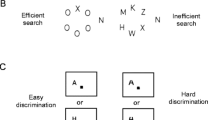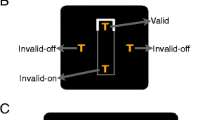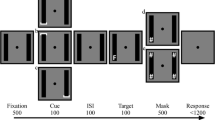Abstract
Because the visual system cannot process all of the objects, colors, and features present in a visual scene, visual attention allows some visual stimuli to be selected and processed over others. Most research on visual attention has focused on spatial or location-based attention, in which the locations occupied by stimuli are selected for further processing. Recent research, however, has demonstrated the importance of objects in organizing (or segregating) visual scenes and guiding attentional selection. Because of the long history of spatial attention research, theories of spatial attention are more mature than theories of other visual processes, such as object segregation and object attention. In the present paper, I outline a biased competition account of object segregation and attention, following similar accounts that have been developed for spatial attention (Desimone and Duncan, 1995). In my biased competition account, I seek to understand how some objects can be segregated and selected over other objects in a complex visual scene. Under this account, there are two sources of visual information that allow an object to be processed over other objects: bottom-up information carried by the physical stimulus and top-down information based on an observer's goals. I use the biased competition account to combine many diverse findings from the object segregation and attention literatures into a common framework.
Similar content being viewed by others
References
Baylis, G.C., 1994: Visual attention and objects: Two-object cost with equal convexity, Journal of Experimental Psychology: Human Perception and Performance 20, 208–212.
Baylis, G.C. and Driver, J., 1993: Visual attention and objects: Evidence for hierarchical coding of location, Journal of Experimental Psychology: Human Perception and Performance 19, 451–470.
Baylis, G.C. and Driver, J., 1992: Visual parsing and response competition: The effect of grouping factors, Perception & Psychophysics 51, 145–162.
Biederman, I., 1987: Recognition-by-components: A theory of human image understanding, Psychological Review 94, 115–147.
Behrmann, M. and Haimson, C., 1999: The cognitive neuroscience of visual attention, Current Opinion in Neurobiology 9, 158–163.
Behrmann, M., Zemel, R. and Mozer, M.C., 1998: Object-based attention and occlusion: Evidence from normal subjects and a computational model, Journal of Experimental Psychology: Human Perception and Performance 24, 1011–1036.
Bundesen, C., 1990: A theory of visual attention, Psychological Review 97, 523–547.
Cohen, J.D., Dunbar, K. and McClelland, J.L., 1990: On the control of automatic processes: A parallel distributed processing account of the Stroop effect, Psychological Review 97, 332–361.
Cohen, J.D. and Huston, T.A., 1994: Progress in the use of interactive models for understanding attention and performance, in C. Umiltá and M. Moscovitch (eds.), Attention and Performance XV. Cambridge, MA: MIT Press, pp. 453–476.
Desimone, R. and Duncan, J., 1995: Neural mechanisms of selective visual attention, Annual Review of Neuroscience 18, 193–222.
Driver, J. and Baylis, G.C., 1989: Movement and visual attention: The spotlight metaphor breaks down, Journal of Experimental Psychology: Human Perception and Performance 15, 448–456.
Driver, J. and Baylis, G.C., 1996: Edge-assignment and figure-ground segmentation in short-term visual matchingm, Cognitive Psychology 31, 248–306.
Driver, J. and Baylis, G.C., 1998: Attention and visual object segregationm, in R. Parasuraman (ed.), The Attentive Brain. Cambridge, MA: MIT Press, pp. 299–325.
Duncan, J., 1984: Selective attention and the organization of visual information, Journal of Experimental Psychology: General 113, 501–517.
Duncan, J. and Humphreys, G.W., 1989: Visual search and stimulus similarity, Psychological Review 96, 433–458.
Egly, R., Driver, J. and Rafal, R.D., 1994: Shifting visual attention between objects and locations: Evidence from normal and parietal lesion subjects, Journal of Experimental Psychology: General 123, 161–177.
Eriksen, B.A. and Eriksen, C.W., 1974: Effects of noise letters upon the identification of a target letter in a nonsearch task, Perception & Psychophysics 16, 143–149.
Eriksen, C.W. and Hoffman, J., 1973: The extent of processing of noise elements during selective encoding from visual displays, Perception & Psychophysics 14, 155–160.
Eriksen, C.W. and St. James, J.D., 1986: Visual attention within and around the field of focal attention: A zoom lens model, Perception & Psychophysics 40, 225–240.
Egeth, H.E. and Yantis, S., 1997: Visual attention: Control, representation, and time course, Annual Review of Psychology 48, 269–297.
Egly, R., Driver, J. and Rafal, R.D., 1994: Shifting visual attention between objects and locations: Evidence from normal and parietal lesion subjects, Journal of Experimental Psychology: General 123, 161–177.
Gibson, B.S., 1994: Visual attention and objects: One versus two or convex versus concave? Journal of Experimental Psychology: Human Perception and Performance 20, 203–207.
Gilds, K.S. and Vecera, S.P., submitted: The Influence of Spatial Attention on Object-based Selection. Manuscript submitted for publication.
Harter,M.R. and Aine, C.J., 1984: Brain mechanisms of visual selective attention, in R. Parasuraman and D.R. Davies (eds.), Varieties of Attention. Orlando, FL: Academic Press, pp. 293–321.
Hinton, G.E. and Lang, K.J., 1985: Shape recognition and illusory conjunctions, in Ninth Annual Joint Conference on Artificial Intelligence. Los Altos, CA.: Morgan-Kaufmann, pp. 252–259.
Hoffman, D.D. and Richards, W.A., 1984: Parts of recognition, Cognition 18, 65–96.
Hoffman, D.D. and Singh, M., 1997: Salience of visual parts, Cognition 63, 29–78.
Jolicoeur, P., 1985: The time to name disoriented natural objects, Memory & Cognition 13, 289–303.
Julesz, B., 1984: A brief outline of the texton theory of human vision, Trends in Neurosciences 6, 41–45.
Kanwisher, N.G. and Driver, J., 1992: Objects, attributes, and visual attention: Which, what, and where, Current Directions in Psychological Science 1, 26–31.
Kienker, P.K., Sejnowski, T.J., Hinton, G.E. and Schumacher, L.E., 1986: Separating figure from ground with a parallel network, Perception 15, 197–216.
Kosslyn, S.M., 1987: Seeing and imagining in the cerebral hemispheres: A computational approach, Psychological Review 94, 148–175.
Kramer, A.F. and Jacobson, A., 1991: Perceptual organization and focussed attention: The role of objects and proximity in visual processing, Perception & Psychophysics 50, 267–284.
Kramer, A.F., Tham, M.-P. and Yeh, Y.-Y., 1991: Movement and focused attention: A failure to replicate, Perception & Psychophysics 50, 537–546.
LaBerge, D. and Brown, V., 1989: Theory of attentional operations in shape identification, Psychological Review 96, 101–124.
Lamme, V.A.F., 1995: The neurophysiology of figure-ground segregation in primary visual cortex, Journal of Neuroscience 15, 1605–1615.
Lavie, N. and Driver, J., 1996: On the spatial extent of attention in object-based visual selection, Perception & Psychophysics 58, 1238–1251.
Lowe, D.G., 1985: Perceptual Organization and Visual Recognition. Boston: Kluwer.
Lowe, D.G., 1987: Three-dimensional object recognition from single two-dimensional images, Artificial Intelligence 31, 355–395.
Marr, D., 1982: Vision. San Francisco: Freeman.
Mozer, M.C. and Sitton, M., 1998: Computational modeling of spatial attention, in H. Pashler (ed.), Attentions. Hove, UK: Psychology Press, pp. 341–393.
Mozer, M.C., Zemel, R.S., Behrmann, M. and Williams, C.K.I., 1992: Learning to segment images using dynamic feature binding, Neural Computation 4, 650–665.
Neisser, U., 1967: Cognitive Psychology. New York: Appleton-Century-Crofts.
Neisser, U. and Becklen, R., 1975: Selective looking: Attending to visually specified events, Cognitive Psychology 7, 480–494.
O'Craven, K.M., Downing, P.E. and Kanwisher, N., 1999: fMRI evidence for objects as the units of attentional selection, Nature 401, 584–587.
Palmer, S.E. and Rock, I., 1994: Rethinking perceptual organization: The role of uniform connectedness, Psychonomic Bulletin & Review 1, 29–55.
Peterson, M.A., 1994: Object recognition processes can and do operate before figure-ground organization, Current Directions in Psychological Science 3, 105–111.
Peterson, M.A., 1999: What's in a stage name? Comment on Vecera and O'Reilly (1998), Journal of Experimental Psychology: Human Perception and Performance 25, 276–286.
Peterson, M.A. and Gibson, B.S., 1991: The initial identification of figure-ground relationships: Contributions from shape recognition processes, Bulletin of the Psychonomic Society 29, 199–202.
Peterson, M.A. and Gibson, B.S., 1993: Shape recognition inputs to figure-ground organization in three-dimensional displays, Cognitive Psychology 25, 383–429.
Peterson, M.A. and Gibson, B.S., 1994a: Object recognition contributions to figure-ground organization: Operations on outlines and subjective contours, Perception & Psychophysics 56, 551–564.
Peterson, M.A. and Gibson, B.S., 1994b: Must figure-ground organization precede object recognition? An assumption in peril, Psychological Science 5, 253–259.
Peterson, M.A., Harvey, E.M. and Weidenbacher, H., 1991: Shape recognition contributions to figure-ground organization: Which routes count? Journal of Experimental Psychology: Human Perception and Performance 17, 1075–1089.
Peterson, M.A. and Hochberg, J., 1983: Opposed-set measurement procedure: A quantitative analysis of the role of local cues and intention in form perception, Journal of Experimental Psychology: Human Perception and Performance 9, 183–193.
Pomerantz, J.R. and Kubovy, M., 1986: Theoretical approaches to perceptual organization, in K.R. Boff, L. Kaufman and J.P. Thomas (eds), Handbook of Perception and Human Performance, volume II. New York: Wiley, pp. 36.1–36.46.
Posner,M.I., 1980: Orienting of attention, Quarterly Journal of Experimental Psychology 32A, 3–25.
Posner,M.I., Snyder, C.R.R. and Davidson, B.J., 1980: Attention and the detection of signals, Journal of Experimental Psychology: General 109, 160–174.
Reicher, G.M., Snyder, C.R.R. and Richards, J.T., 1976: Familiarity of background characters in visual scanning, Journal of Experimental Psychology: Human Perception and Performance 2, 522–530.
Roelfsema, P.R, Lamme, V.A.F. and Spekreijse, H., 1998: Object-based attention in the primary visual cortex of the macaque monkey, Nature 395, 376–381.
Rock, I., 1975: An Introduction to Perception. New York: MacMillan.
Rubin, E., 1915/1958: Figure and ground, in D.C. Beardslee and M. Wertheimer (eds), Readings in Perception. Princeton, NJ: Van Nostrand, pp. 194–203. (Original work published 1915.)
Sagi, D. and Julesz, B., 1984: Detection versus discrimination of visual orientation, Perception 13, 619–628.
Sandon, P.A., 1990: Simulating visual attention, Journal of Cognitive Neuroscience 2, 213–231.
Schyns, P.G. and Murphy, G.L., 1994: The ontogeny of part representation in object concepts, in D.L.Medin (ed.), The Psychology of Learning and Motivations, Volume 31.San Diego: Academic Press, pp. 305–349.
Sejnowski, T.J. and Hinton, G.E., 1987: Separating figure from ground with a boltzmann machine, in M.A. Arbib and A.R. Hanson (eds), Vision, Brain, and Cooperative Computation. Cambridge, MA: MIT, pp. 703–724.
Shulman, G.L., 1992: Attentional modulation of a figural aftereffect, Perception 21, 7–19.
Sperling, G. and Weichselgartner, E., 1995: Episodic theory of the dynamics of spatial attention, Psychological Review 102, 503–532.
Tarr, M.J., 1995: Rotating objects to recognize them: A case study on the role of viewpoint dependency in the recognition of three-dimensional objects, Psychonomic Bulletin & Review 2, 55–82.
Treisman, A., 1988: Features and objects. The fourteenth Bartlett memorial lecture, Quarterly Journal of Experimental Psychology 40A, 201–237.
Treisman, A. and Gelade, G.A., 1980: A feature-integration theory of attention, Cognitive Psychology 12, 96–136.
Vecera, S.P., 1994: Grouped locations and object-based attention: Comment on Egly, Driver, & Rafal (1994), Journal of Experimental Psychology: General 123, 316–320.
Vecera, S.P., Behrmann, M. and Filapek, J.C., in press: Attending to the parts of a single object: Part-based selection limitations, Perception & Psychophysics.
Vecera, S.P., Behrmann, M. and McGoldrick, J., 2000: Selective attention to the parts of an object, Psychonomic Bulletin & Review 7, 301–308.
Vecera, S.P. and Farah, M.J., 1994: Does visual attention select objects or locations? Journal of Experimental Psychology: General 123, 146–160.
Vecera, S.P. and Farah, M.J., 1997: Is visual image segmentation a bottom-up or an interactive process? Perception & Psychophysics 59, 1280–1296.
Vecera, S.P. and Luck, S.J., 2000: Attention, in V.S. Ramachandran (ed.), Encyclopedia of the Human Brain. San Diego: Academic Press.
Vecera, S.P. and O'Reilly, R.C., 1998: Figure-ground organization and object recognition processes: An interactive account, Journal of Experimental Psychology: Human Perception and Performance 24, 441–462.
Vecera, S.P. and O'Reilly, R.C., 2000: Graded effects in hierarchical figure-ground organization: Reply to Peterson (1999), Journal of Experimental Psychology: Human Perception and Performance 26, 1221–1231.
Watson, S.E. and Kramer, A.F., 1999: Object-based visual selective attention and perceptual organization, Perception & Psychophysics 61, 31–49.
Wolfe, J.M., 1994: Guided search 2.0: A revised model of visual search, Psychonomic Bulletin & Review 1, 202–238.
Wolfe, J.M., 1998: Visual search, in H. Pashler (ed.), Attention. Hove, UK: Psychology Press, pp. 15–73.
Wong, E. and Weisstein, N., 1983: Sharp targets are detected better against a figure, and blurred targets are detected better against a background, Journal of Experimental Psychology: Human Perception and Performance 9, 194–202.
Woodman, G.F., Vogel, E.K. and Luck, S.J., submitted: Visual Search Remains Efficient when Working Memory is Full. Manuscript submitted for publication.
Yantis, S., 1998: Control of visual attention, in H. Pashler (ed.), Attention. Hove, UK: Psychology Press, pp. 223–256.
Yantis, S. and Jonides, J., 1984: Abrupt visual onsets and selective attention: Evidence from visual search, Journal of Experimental Psychology: Human Perception and Performance 10, 601–621.
Zipser, K., Lamme, V.A.F. and Schiller, P.H., 1996: Contextual modulation in primary visual cortex, Journal of Neuroscience 16, 7376–7389.
Author information
Authors and Affiliations
Rights and permissions
About this article
Cite this article
Vecera, S.P. Toward a Biased Competition Account of Object-Based Segregation and Attention. Brain and Mind 1, 353–384 (2000). https://doi.org/10.1023/A:1011565623996
Issue Date:
DOI: https://doi.org/10.1023/A:1011565623996




